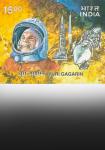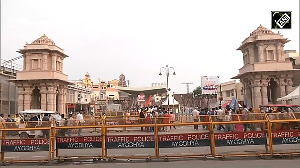 There's only one question left about billionaire Lakshmi Mittal: when will he become the King of Steel? The short answer: in about six months.
There's only one question left about billionaire Lakshmi Mittal: when will he become the King of Steel? The short answer: in about six months.
That's when he's scheduled to clinch the deal to buy Polskie Huty Stali, a rundown Communist-era steel conglomerate in Poland.
When the ink's dry on that deal, Mittal will either have seized the global crown or he will be a million tonnes or so behind Accelor, the current world number one.
But there's one vital difference between Mittal's LNM Group and Accelor.
The LNM Group is racing at lightning speed compared to its lumbering, slow-moving rivals in the world of steel. Accelor, a 46 million tonne (mt) behemoth -- formed in 2001 by the merger of three European steel companies -- hasn't moved into takeover mode after its amalgamation.
By contrast, the LNM Group has kept up a blistering pace through good times and bad. It currently produces about 38 mt of steel but it's upping production steeply and constantly scouting for new acquisitions.
His bid for the top slot is all the more remarkable because he has -- like the rest of the steel industry -- just weathered remarkably tough times.
Four years ago, as the steel industry slumped into one of the worst recessions in modern times, it was belt-tightening time at the LNM Group.
Soon afterwards his efforts to grab a share of the e-business pie also evaporated into cyberspace.
He attempted to marry technology and steel by setting up an e-exchange where steel could be traded, but the effort was aborted.
His venture capital fund which hoped to strike a gusher in the hi-tech sector also didn't score any big multi-bagger hits.
Nevertheless, in 2003 Mittal is triumphantly reaching for the top. Despite the recession, he bought stakes in four companies in three years and has almost doubled capacity.
In the process the LNM Group has moved from 6th position in the industry to the second slot. It has pulled this off in the face of mounting competition from other industry giants who are now trying to emulate Mittal's tactics.
He now owns -- or part owns -- 12 giant-sized mills that are part of a far-flung empire stretching from Canada to Trinidad & Tobago to Kazakhstan and Indonesia.
Says Mittal: "There have been a number of interesting opportunities over the past three years, as a result of which we have grown considerably in a relatively short period of time."
As the LNM Group turns around smartly the profits have also poured in. In 2002 on revenues of $8.7 billion the group made net profits of $613 million.
Astonishingly, the biggest profits are coming from Mittal's riskiest and most ambitious buy. The giant Karmet steelworks in Kazakhstan bought in 1995 was reckoned to be a knife-edge gamble when it was bought.
Famously, when the LNM Group bought the plant, it also inherited the local branch of the KGB and the steel town's tram service. Today production has climbed from 2.2 million tonnes when the LNM Group took over to 5.2 million tonnes.
Fortune, as the old saying goes, favours the brave and Mittal has had giant-sized slices of luck on the way. The Karmet plant is perfectly positioned to supply the steel-hungry Chinese market, which has developed an insatiable appetite for the commodity (it's about 400 miles from the Chinese border).
Since Chinese demand is almost the sole factor driving global steel prices upwards, Karmet is now in a win-win position. To keep pace with demand the LNM Group has hiked production steeply by over a million tonnes this year at Karmet.
Also, the group has opened sales offices in China. Says Mittal: "Demand from China continues to rise and Karmet is in an excellent position to benefit from this."
But Mittal, in the last decade, has never let an opportunity pass. He has voraciously gobbled up steel plants around the world.
In the last three years he has moved from Algeria to South Africa to Romania and the Czech Republic, grabbing nationalised rustbuckets that were being privatised -- and which other steelmakers were afraid to touch.
In each he has had an alchemist's effect. At Ispat Sidex in the Czech Republic, production climbed from 3.04 million tonnes to 3.65 million tonnes, a year after it was acquired.
Similarly, production has already zoomed at Ispat Nova Hut in the Czech Republic where the deal was closed last year.
Mittal denies that he's concentrating mainly on Eastern Europe. "We take opportunities where we find them," says a company spokesman.
Indeed that seems to be the truth. In 2001 the LNM Group took a 70 per cent stake in Algerian company Ispat Annaba. Similarly, it has a 47 per cent stake in Iscor, a South African steel company.
On one occasion earlier this year, as the pace of acquisitions heated up, LNM Group chief financial officer Sudhir Maheshwari, found himself jetting straight from Poland to South Africa dealing with one takeover bid after another.
What's the glue that binds this disparate empire? The best explanation is that Mittal has a remarkable eye for a bargain and has figured the art of turning around rundown steel mills -- also he is willing to walk away from a deal if the price is not right.
Rivals say that his investment per tonne has always been low throughout his career as a takeover artist.
Says one London-based analyst: "The assets he buys are not in good condition and most people shy away from that. LNM seems to have a skill at managing that type of problem."
Once LNM takes over a plant -- whether in Kazakhstan or in Canada -- it flies in a crack team that always includes large numbers of Indian executives.
Most have been handpicked from the Steel Authority of India during the last decade.
LNM Group President, Malay Mukherjee, was a former general manager in Bhilai and was the man-on-the-spot soon after the Karmet takeover.
Another former SAIL employee Narendra Chaudhary is the managing director of Ispat Sidex in Romania and K A P Singh the chief operating officer at Nova Hut.
International analysts have always given the SAIL managers high marks for their skills. Says one analyst: "They are willing to work seven days a week in the most remote locations."
Also, after working in places like Rourkela and Bokaro, they also know everything there is to know about rusty state-run enterprises.
To understand how the LNM Group operates, it is first necessary to look at its structure.
The group consists of two halves. The first is a publicly listed company, Ispat International, which includes a clutch of steel mills from Canada to the Caribbean.
The second is the privately held, LNM Holdings, which controls a string of companies (usually in more difficult locations) including Karmet and the other eastern European mills.
Unfortunately, Ispat International didn't live up to its initial promise when it listed in 1997.
Unusually for a steel company, the company's $ 775 million IPO was seven times oversubscribed and its shares opened at $28.5. That year The Sunday Times reckoned that Mittal was one of Britain's richest tycoons worth around £2.2 billion.
But the company's stock quickly slipped. It hovered around $9 for a long time and as the steel industry recession became worse it tumbled to a low of $1.9. Now, it has climbed back to around $5.
Mittal has always insisted that he hasn't lost faith in listed companies. But all his recent buys have been carried out under the aegis of the privately held LNM Holdings.
The result is that today Ispat International produces about 17,050 mt of steel and the privately held companies produce about 19,150 mt.
It should be noted by comparison that India currently produces about 33 mt of steel annually. India's largest producer SAIL produces about 9.5 mt. Tata Steel produced 3.94 mt and plans to add another million tonnes by 2005.
Mittal, who has long stopped gauging himself against the Indian steel industry, made the leap into the global top table during the '90s. Back in 1998 the LNM Group announced its arrival by bidding $1.4 billion for US rust-belt giant Inland Steel.
That is still its single biggest acquisition but it is spending giant amounts on plants it has bought recently. It plans to invest a total of around $500 million at Iscor. It's reckoned that the group invested about $700 million on upgrades at Karmet.
There have been deals that have stayed out of reach along the way. A few years ago, the LNM Group was on the verge of clinching a deal to buy Sidor, a Venezuelan plant but found the prize snatched from it at the last moment.
More recently, the going has become even tougher. Other steel giants are learning to play Mittal's game. The main competitor is U.S. Steel which beat the LNM Group in the race for VSZ in Slovakia. This year, it also beat Mittal to the draw for Sartid, a Serbian plant.
Similarly, both U.S. Steel and Accelor, bid for Polskie Huty Stali which seems almost certain now to fall into Mittal's empire.
The story of how Mittal rose from relative obscurity to become a modern day Andrew Carnegie is relatively well known.
He was born in Sadulpur, Rajasthan. His father's business Ispat India has weathered many storms in the last decade.
At the tender age of 26 Lakshmi Mittal was despatched to Indonesia to oversee the family's mill now called Ispat Indo. Lakshmi Mittal parted ways with his father's in 1995.
In the late '80s, Mittal moved into acquisition mode and bought mills in places like Trinidad and followed that up in Canada.
The greatest coup was when he snapped up the loss-making Sibalsa Mill in Mexico for $220 million in 1992. The 20-year-old facility was originally built by the Mexican Government for around $2 billion.
Most steel industry analysts say the deal was extremely favourable and till recently the plant was the mainstay of the LNM empire.
His mills in Trinidad and Canada and Ispat Mexicana gave him a strong base in North America. In 1998 he consolidated his position in the continent by buying Inland Steel.
In the mid-'90s Mittal decided that he needed a more central base for his rapidly growing empire and shifted to London. There he set the tone that other Indian industrialists have watched enviously -- and some have tried to emulate. His neighbours in Bishop's Avenue, Hampstead include the Sultan of Brunei and King Fahd of Saudi Arabia.
And other Indian businessmen -- perhaps hoping that the Mittal effect would rub off on them -- have also taken up premises near the LNM office in Berkeley Square House, Mayfair.
Mittal has always insisted that he is on the lookout for buys anywhere in the world. But he seems to have followed a clear pattern.
In the early '90s he focused mainly on North America then he shifted focus to Western Europe and bought plants in Ireland, France and Germany.
These moves gave him a strong hold in the western European market for what are called long products.
His moves in eastern Europe could also pay off in a big way. By 2005 the Czech Republic and Poland will be part of the enlarged EU and by 2007 Romania will also join the fold.
That means the LNM Group will probably be producing around 15 million tonnes in the EU.
Says Mittal: "The major companies in eastern Europe are now privatised. The opportunities now lie in the enlargement of the EU into central and eastern Europe."
As it set out on the acquisition trail, the LNM Group hasn't been afraid to leverage itself.
At Ispat Karmet, for example, it took a $450 million package put together by the European Bank for Reconstruction and Development (EBRD) and the IFC. Similarly, at Sidex it has taken a $100 million EBRD loan.
What next? Mittal once said that a modern steel company would be right-sized at around 20mt. He has now upped that to around 40mt and admits that he might double that once again.
But as the industry consolidates it looks certain that Lakshmi Mittal will be out there in front stoking up blast furnaces around the world.






 © 2025
© 2025